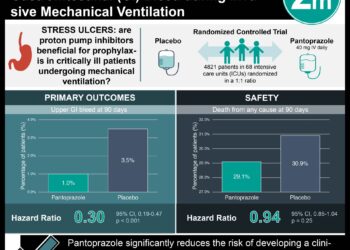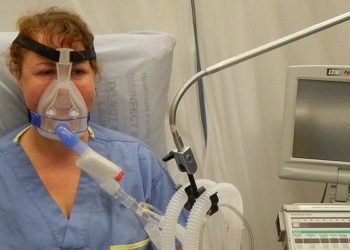The ARMA trial: Lower tidal volume ventilation in ALI/ARDS [Classics Series]
1. The trial was terminated early when the data demonstrated that lower tidal volume ventilator settings in ALI/ARDS patients led to a significant decrease in in-hospital mortality.
2. Low tidal volume ventilation also led to an increase in ventilator-free days and a decrease in the number of days with systemic organ failure. There was no change in the incidence of barotrauma between the two groups.
3. Patients assigned to lower tidal volume ventilator settings initially required a higher PEEP to maintain arterial oxygenation and were more likely to develop respiratory acidosis, although the difference disappeared by day 7.
Original Date of Publication: May 4, 2000
Study Rundown: Traditionally, patients with acute lung injury (ALI) or acute respiratory distress syndrome (ARDS) requiring mechanical ventilation were subjected to higher tidal volumes (10-15 mL/kg) than a healthy individual, in an effort to maintain normal partial pressure of carbon dioxide and arterial pH. However, studies in animals showed that higher tidal volumes were associated with increased lung inflammation and injury. This multi-center, randomized, controlled trial compared traditional tidal volume therapy (12 mL/kg) to low tidal volume therapy (6 mL/kg) in mechanically ventilated patients with ALI/ARDS for 28 days. Results showed that the traditional tidal volume group had significantly increased in-hospital mortality compared to the low tidal volume group (p=0.007). There was no difference in barotrauma between the two groups.
In summary, this study demonstrates that lower tidal volumes in ALI/ARDS patients reduced in-hospital mortality and the number of days that patients required use of the ventilator. Of note, patients in the lower tidal volume group required higher PEEP and had a slight, but significant, respiratory acidosis, both of which resolved after 7 days. This suggests that though lower tidal volumes required a higher respiratory rate to maintain adequate ventilation, its benefits on mortality outweighed the transient acid/base and oxygenation imbalances that were effectively managed with higher PEEP and sodium bicarbonate infusion, respectively.
Click to read the study in NEJM
Click to read an accompanying editorial in NEJM
In-Depth [randomized, controlled trial]: Originally published in 2000 in NEJM, this trial was conducted at 10 university centers across the United States from 1996-1999. Eligible patients were all patients above the age of 18 who were intubated and mechanically ventilated and had an acute decrease to a P/F ratio (partial pressure of arterial oxygen to fraction of inspired oxygen) of 300 or less with evidence of bilateral lung edema on recent chest x-ray. Patients with chronic lung disease, high pulmonary capillary wedge pressure or evidence of left atrial hypertension, less than 6 months of estimated survival, and other medical problems that would cause poor respiration or oxygenation, were excluded. Patients were randomized to traditional tidal volume therapy of 12 mL/kg or low tidal volume therapy of 6 mL/kg for 28 days. Patients were followed up weekly for a total of 180 days. The primary endpoint was in-hospital mortality, with significant reduction from 39.8% in the traditional group to 31.0% in the low tidal volume group (p=0.007, 95% CI 2.4-15.3%). There was also a significant decrease in the number of ventilator-free days in the low tidal volume group (p=0.007) and in the number of days free from organ failure (p=0.006).
Image: PD
© 2013 2minutemedicine.com. All rights reserved. No works may be reproduced without written consent from 2minutemedicine.com. Disclaimer: We present factual information directly from peer reviewed medical journals. No post should be construed as medical advice and is not intended as such by the authors or by 2minutemedicine.com. PLEASE SEE A HEALTHCARE PROVIDER IN YOUR AREA IF YOU SEEK MEDICAL ADVICE OF ANY SORT. Content is produced in accordance with fair use copyrights solely and strictly for the purpose of teaching, news and criticism. No benefit, monetary or otherwise, is realized by any participants or the owner of this domain.







